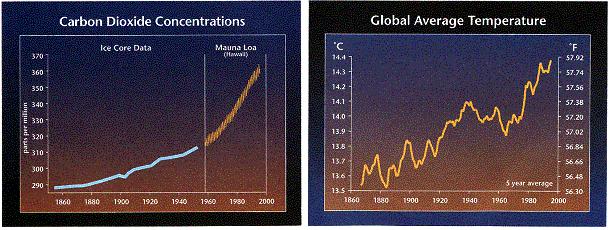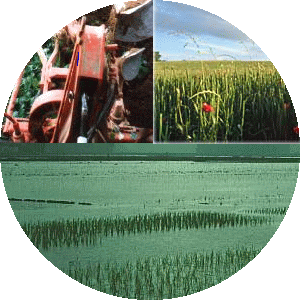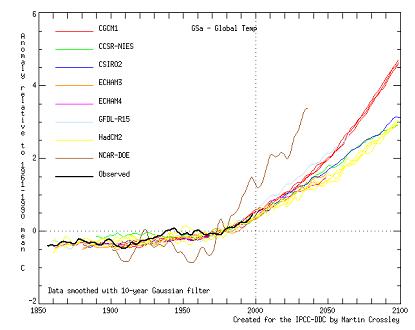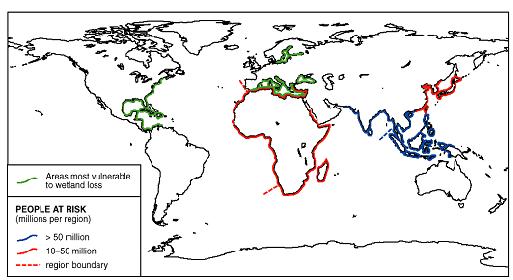 > ENC Master > Climate Encyclopaedia > Food & Climate > more > 2. Predicting the future > - global changes
> ENC Master > Climate Encyclopaedia > Food & Climate > more > 2. Predicting the future > - global changes
 |
|
|
|
|
From industrial development to global changesIncrease in carbon dioxide Through burning fossil fuels and eradication of forests, human activity has caused the carbon dioxide (CO2) concentration of the atmosphere to increase by some 25% since the industrial revolution, and that increase continues.
|
|
CO2 plays an important role in inhibiting the escape of the heat radiated by the earth. The sun beams short-wave radiation to the earth, which sends long-wave radiation back to space. Greenhouse gases in the earth’s atmosphere (carbon dioxide, water vapour, methane, nitrous oxide, and the chlorofluorocarbons) absorb the outgoing radiation, thereby holding heat near our planet. This process occurs naturally: without the natural greenhouse effect, our planet would be near freezing. Instead, this process warms the earth to its current mean temperature of about 15ºC.
|
 |
|
1. Measurements made on Mauna Loa in Hawaii since 1956 reveal the recent CO2 trend
|
The greenhouse effectThe concern now is that human activities are causing the natural greenhouse effect to be augmented, leading to significant changes in the temperature and related changes in the entire climate system. Has global warming actual begun? When we look at the Earth’s global average temperature over the last century, we find that temperatures have risen about 0.5ºC. The decade of the 1990s is the warmest on record. While it is difficult to prove conclusively that rising CO2 is causing the earth to warm, scientists believe that the two trends -- increasing carbon dioxide and increasing temperatures – are likely to be linked (IPCC, 1996a).
|
|
At least ten GCMs have been developed by atmospheric scientists in various research groups and have been used to project the effects of greenhouse gas increases. Results from these simulations show a mean global warming in the range of 1.4 to 5.8ºC by the end of the next century. When the effects of sulphate aerosols are included in the projections, the best estimate for 2100 is a temperature increase in the range of 1.0 to 3.5ºC. The latter projections are somewhat cooler since sulphate aerosols from industrial pollution tend to cool the earth’s atmosphere by reflecting short wave solar radiation. Global climate models also predict an increase in mean global precipitation ranging from about 5 to 20% due to the fact that a warmer atmosphere can hold more water vapour.
|
|
GCMs further predict that: • The high latitudes and high elevations are likely to continue to experience greater warming than the global mean warming, especially in winter. • Winter and night time temperatures (minimum temperatures or TMINs) are projected to continue to rise disproportionately. • The hydrological cycle is likely to further intensify, bringing more floods and more droughts. • More winter precipitation is projected to fall as rain, rather than snow, decreasing snow pack and spring runoff, potentially exacerbating springs and summer droughts.
|
 |
|
3. Changes in temperature and precipitation
|
Sea level rise scenariosGlobal warming will also affect the sea-level. There has been a range of estimates for sea-level rise based on greenhouse gas emissions, and temperature projections that affect the expansion of the water in the oceans, and glacial melting. Because some coastal areas are sinking and others rising, sea-level rise scenarios are added to current trends. Recent estimates are on the order of a 0.5 m rise by 2100. |
|
Socio-economic ScenariosClimate is not the only factor that will be changing as the twenty-first century unfolds. Population growth and changing economic and technological conditions are likely to affect world society and the environment even more than changes in climate. It is important to take such changes into account in climate change impact analyses: first, because climate change will occur not in the present but in the future, and second, because such changes may affect the sensitivity of agriculture (or other sectors) to climate change. However, predicting population growth rates and future economic conditions is equally if not more uncertain than predicting the future climate.
|
Related pages:For more information about sea level rise: To know more about the consequences of climate change for humans go to:
|
Author: Marta Moneo and Ana Iglesias- Universidad Politécnica de Madrid - España |


